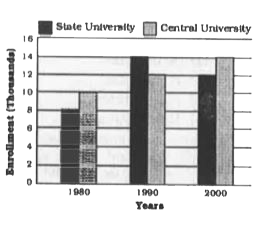Study the given information carefully and answer the given questions
The revenue of a given railway zone was collected from four primary sources— Offline Ticket Sales, Online Ticket Sales, Freight, fines during three Financial Years (FY2013-14, FY2014-15, FY2015-16)
2013-14: Total revenue collected was ₹3500 crore, Fines(₹ x crore) comprised 767% of the total revenue and revenue from online ticket sales was ₹x+300 crore. Revenue from freight was 12% more than that from offline ticket sales
FY 2014-15 : Revenue from online ticket sale increased by 25 crores over FY 2013-14. Revenue from offline ticket sale was 40 % of the total revenue in FY 2014-15. Revenue from Freight and Fines was in the respective ratio of 5:1
FY 2015-16: Revenue from fines in FY 2013-14 was 1116 th of that in FY2015-16. Revenue from online ticket sales increased by 50% over that in FY 2014-15 and that from offline ticket sales was the average of that in FY 2013-14 and 2014- 15. Revenue from freight has been and will continue to increase steadily by ₹250 crore every financial year
In FY 2017-18, if the revenue from fines increases by 20%over FY 2015-16, what would be the ratio between the revenues from fines and freight in FY 2017-18
2:3
1:5
2:5
3:4
The correct Answer is:B
To solve the problem, we will go through the information step by step, calculating the revenues for each financial year and finally determining the ratio of fines to freight in FY 2017-18.
Step 1: Calculate Revenue for FY 2013-14
- Total Revenue: ₹3500 crore
- Fines: 767100 of ₹3500 crore = \frac{53}{7} \times 35 = ₹250 crore
- Online Ticket Sales: Let fines be x crore, then revenue from online ticket sales is x+300 crore. Thus, 250+(x+300)+Offline Ticket Sales+Freight=3500.
Step 2: Set Up the Equation for FY 2013-14
Let the revenue from offline ticket sales be y crore and from freight be 1.12y (12% more than offline ticket sales).
- Total revenue equation:
250+(x+300)+y+1.12y=3500
250+(x+300)+2.12y=3500
x+2.12y=3500−550
x+2.12y=2950
Step 3: Substitute Fines Value
From the previous calculation, we found x=250.
- Substitute x:
250+2.12y=2950
2.12y=2950−250
2.12y=2700
y=27002.12≈1270.75 crore (Offline Ticket Sales)
- Freight Revenue: 1.12y=1.12×1270.75≈1424.84 crore
Step 4: Calculate Revenue for FY 2014-15
- Online Ticket Sales: Increased by ₹25 crore over FY 2013-14 = ₹575 crore.
- Offline Ticket Sales: 40% of total revenue.
- Total Revenue: 0.4×Total Revenue=y
Let total revenue for FY 2014-15 be T:
0.4T+0.2T+0.2T=T
- Fines and Freight ratio = 5:1, thus:
Freight=5x,Fines=x
- Total Revenue = 575+0.4T+5x+x=T
Step 5: Calculate Revenue for FY 2015-16
- Fines: 1116 of FY 2013-14 = 1116×250=173.75 crore
- Online Ticket Sales: 50% increase over FY 2014-15 = 575×1.5=862.5 crore
- Offline Ticket Sales: Average of FY 2013-14 and FY 2014-15 = 1270.75+17202≈1495.375 crore
- Freight: 1424.84+250=1674.84 crore
Step 6: Calculate Revenues for FY 2017-18
- Fines: Increased by 20% over FY 2015-16 = 173.75×1.2=208.5 crore
- Freight: Increased by ₹250 crore from FY 2016-17 = 1674.84+250=1924.84 crore
Step 7: Calculate the Ratio of Fines to Freight in FY 2017-18
- Fines: ₹208.5 crore
- Freight: ₹1924.84 crore
- Ratio:
Ratio=FinesFreight=208.51924.84≈1:9.23
Final Answer
The ratio between the revenues from fines and freight in FY 2017-18 is approximately 1:9.23.
- Total Revenue: ₹3500 crore
- Fines: 767100 of ₹3500 crore = \frac{53}{7} \times 35 = ₹250 crore
- Online Ticket Sales: Let fines be x crore, then revenue from online ticket sales is x+300 crore. Thus, 250+(x+300)+Offline Ticket Sales+Freight=3500.
Let the revenue from offline ticket sales be y crore and from freight be 1.12y (12% more than offline ticket sales).
- Total revenue equation:
250+(x+300)+y+1.12y=3500
250+(x+300)+2.12y=3500
x+2.12y=3500−550
x+2.12y=2950
From the previous calculation, we found x=250.
- Substitute x:
250+2.12y=2950
2.12y=2950−250
2.12y=2700
y=27002.12≈1270.75 crore (Offline Ticket Sales)
- Freight Revenue: 1.12y=1.12×1270.75≈1424.84 crore
- Online Ticket Sales: Increased by ₹25 crore over FY 2013-14 = ₹575 crore.
- Offline Ticket Sales: 40% of total revenue.
- Total Revenue: 0.4×Total Revenue=y
0.4T+0.2T+0.2T=T
- Fines and Freight ratio = 5:1, thus:
Freight=5x,Fines=x
- Total Revenue = 575+0.4T+5x+x=T
- Fines: 1116 of FY 2013-14 = 1116×250=173.75 crore
- Online Ticket Sales: 50% increase over FY 2014-15 = 575×1.5=862.5 crore
- Offline Ticket Sales: Average of FY 2013-14 and FY 2014-15 = 1270.75+17202≈1495.375 crore
- Freight: 1424.84+250=1674.84 crore
- Fines: Increased by 20% over FY 2015-16 = 173.75×1.2=208.5 crore
- Freight: Increased by ₹250 crore from FY 2016-17 = 1674.84+250=1924.84 crore
- Fines: ₹208.5 crore
- Freight: ₹1924.84 crore
- Ratio:
Ratio=FinesFreight=208.51924.84≈1:9.23
The ratio between the revenues from fines and freight in FY 2017-18 is approximately 1:9.23.
Similar Questions
Knowledge Check
Total revenue=
APrice × quantityBPrice × incomeCIncome × quantityDNone of theseStudy the following bar graph carefully and answer the questions.

The tuition fee at State University in the year 2000 was Rs.6500 per nrolment. What was the total revenue collected from the tuition fee at State University during the year?ARs.80,000,000BRs.78,000,000CRs.65,000,000DRs.56,000,000Sale is recognised as revenue
Awhen the contract for sale is entered intoBat the point of sale or performance of serviceCafter the expiry of credit period allowed to debtorsDafter the money collected from the customers
'Study then following bar graph carefully and answer the questions.

The tuition fee at State University in the year 2000 was Rs.6500 per enrollment.What was the total revenue collected from the tuition fee at State university during that year?
View SolutionA rectangular plot is 180m^2 in area. If its length is 18m, then its perimeter is?
View SolutionThe table given below shows the revenue (in crores) of a company from years 2010 to 2016)

What is the percentage change in the revenue from year 2010 to 2014?
View SolutionWhat is the total value of revenue of the firm (in crores Rs) in years 2010, 2011 and 2012?
View SolutionThe price of an article decreased by 20% as a result of which the sale increased by 10%. What will be the effect on the total revenue of the shop?
View Solution


